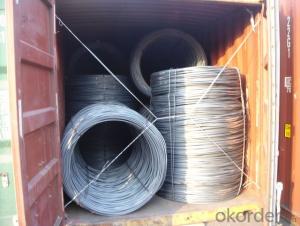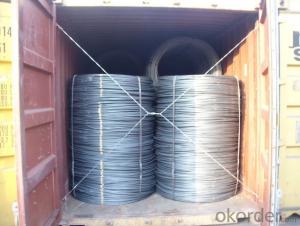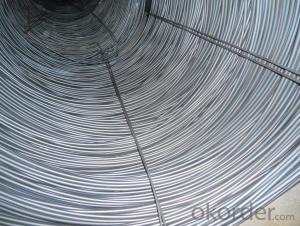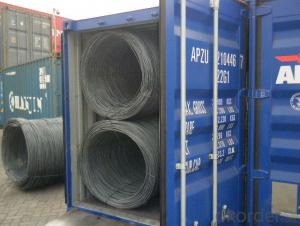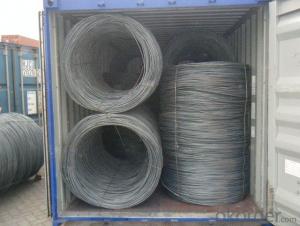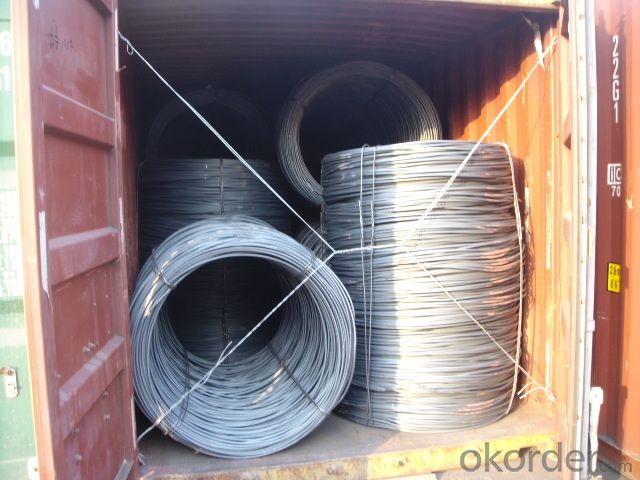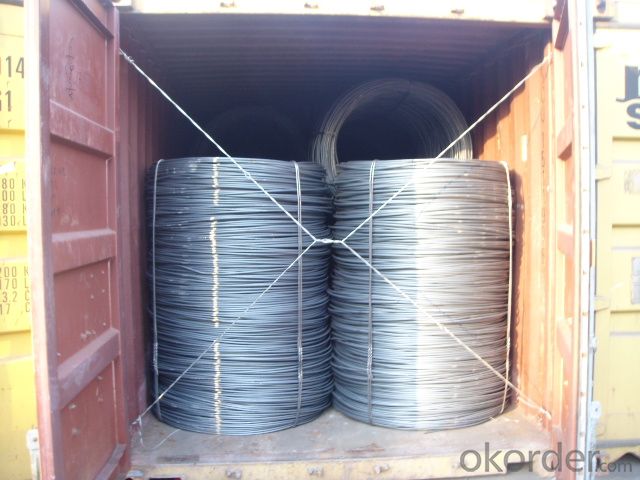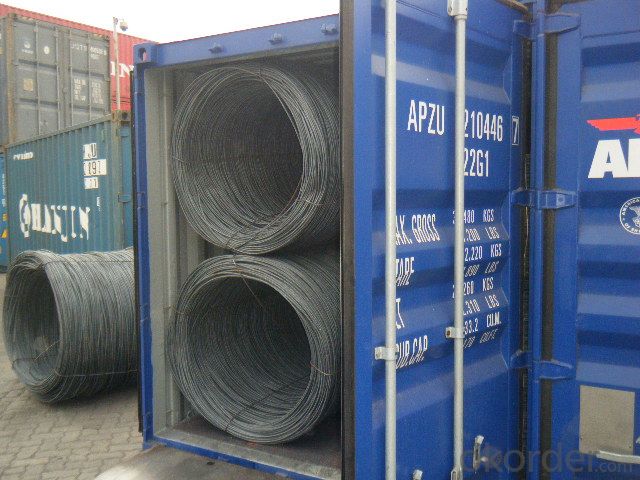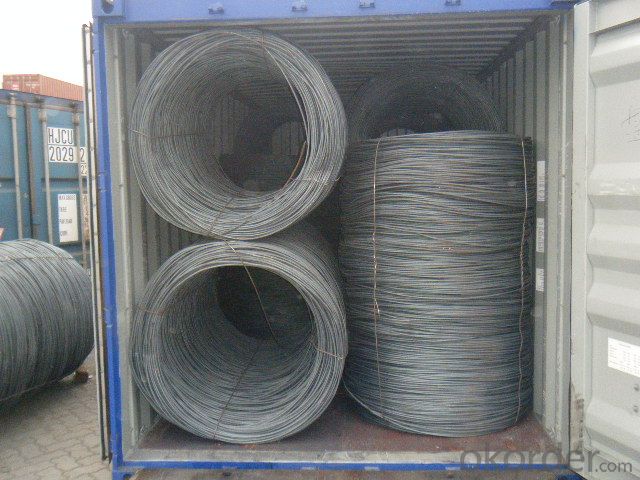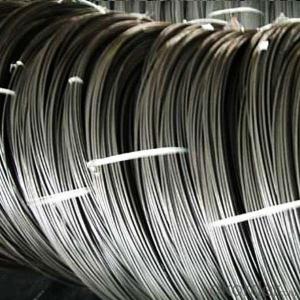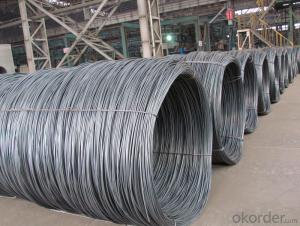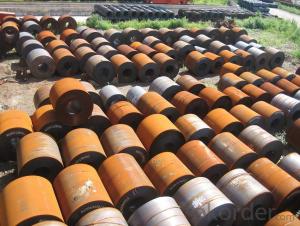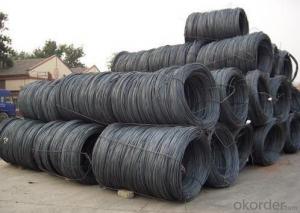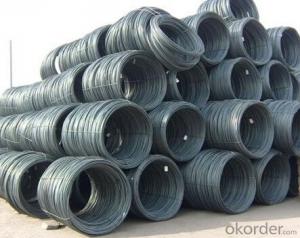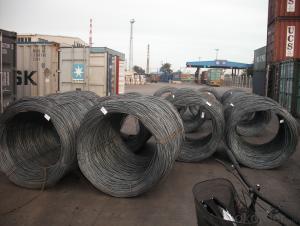Hot Rolled Wire Rod of Steel Grade: Q195/235
- Loading Port:
- Tianjin
- Payment Terms:
- TT OR LC
- Min Order Qty:
- 100 m.t.
- Supply Capability:
- 2000 m.t./month
OKorder Service Pledge
OKorder Financial Service
You Might Also Like
Product Description:
OKorder is offering Hot Rolled Wire Rod of Steel Grade: Q195/235 at great prices with worldwide shipping. Our supplier is a world-class manufacturer of steel, with our products utilized the world over. OKorder annually supplies products to European, North American and Asian markets. We provide quotations within 24 hours of receiving an inquiry and guarantee competitive prices.
Product Applications:
Hot Rolled Wire Rod of Steel Grade: Q195/235 are ideal for structural applications and are widely used in the construction of buildings and bridges, and the manufacturing, petrochemical, and transportation industries.
Product Advantages:
OKorder's Hot Rolled Wire Rod of Steel Grade: Q195/235 are durable, strong, and resist corrosion.
Main Product Features:
· Premium quality
· Prompt delivery & seaworthy packing (30 days after receiving deposit)
· Corrosion resistance
· Can be recycled and reused
· Mill test certification
· Professional Service
· Competitive pricing
Specifications of Hot Rolled Wire Rod:
Steel Grade: Q195/235, SAE1006-1018B Standard: ASTM, GB
Diameter: 5.5mm, 6.5mm, 7mm,8mm,9mm,10mm,12mm,14mm
Type: in coil, coil weight around 2MT Alloy or Not: Alloy
Technique: Hot Rolled
Place of Origin: China Mainland
Surface: round, no twisted, light and smooth
Chemical Composition: (Please kindly find our chemistry of our material based on Q195、Q235A and Q235B as below for your information)
Trademark | Rank | Chemical composition (quality score) % | ||||||
C | Si | Mn | S | P | ||||
| ≤ |
| ≤ | ≤ | ||||
Q195 |
| 0.06-0.12 | 0.30 | 0.25 | 0.050 | 0.045 | ||
Q235 | A | 0.14-0.22 | 0.30 | 0.30-0.65 | 0.050 | 0.045 | ||
Q235 | B | 0.12-0.20 | 0.30 | 0.30-0.70 | 0.045 | 0.045 | ||
Usage and Applications of Hot Rolled Wire Rod:
After hot-rolled the products shaped into coil and delivery as finished product, including round, square, rectangular, hexagonal and so on. Since most of the products are round, it is generally called wire rod. Carbon steel wire rod is widely used in construction and manufacturing. Carbon steel wire rod is mainly used for reinforcement of reinforced concrete and welded structure or reprocessed (roberts , nail, etc.) materials, especially used to produce wire drawing, welding electrode, nails, spring, electronic, precise machinery parts and so on.
Packaging & Delivery of Hot Rolled Wire Rod:
Packaging Detail: products are packed in coil, each coil weight around 2 MT, and then shipped by container or bulk vessel
Delivery Detail: within 45 days after received deposit or LC.
Label: to be specified by customer, generally, each bundle has 1-2 labels
Trade terms: FOB, CFR, CIF
FAQ:
Q1: Why buy Materials & Equipment from OKorder.com?
A1: All products offered byOKorder.com are carefully selected from China's most reliable manufacturing enterprises. Through its ISO certifications, OKorder.com adheres to the highest standards and a commitment to supply chain safety and customer satisfaction.
Q2: How do we guarantee the quality of our products?
A2: We have established an advanced quality management system which conducts strict quality tests at every step, from raw materials to the final product. At the same time, we provide extensive follow-up service assurances as required.
Q3: How soon can we receive the product after purchase?
A3: Within three days of placing an order, we will begin production. The specific shipping date is dependent upon international and government factors, but is typically 7 to 10 workdays.
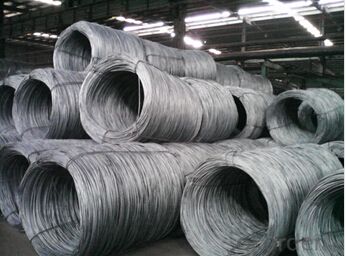
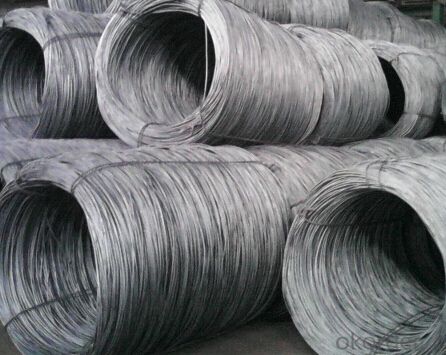
- Q: What are the different types of steel used for manufacturing wire rod?
- There are several different types of steel used for manufacturing wire rod, including low carbon steel, high carbon steel, alloy steel, and stainless steel. Each type of steel has its own unique properties and characteristics, making it suitable for specific applications and industries. Low carbon steel is commonly used for general-purpose wire rod, while high carbon steel is used for applications requiring high strength and durability. Alloy steel is used when additional properties such as heat resistance or corrosion resistance are required. Stainless steel, on the other hand, is used for applications that require excellent corrosion resistance, such as in the automotive or construction industry.
- Q: What are the different surface finishes of steel wire rod available?
- There are several different surface finishes available for steel wire rod, including black, pickled and oiled, galvanized, and coated.
- Q: What are the main challenges faced by the steel wire rod industry?
- The main challenges faced by the steel wire rod industry include fluctuating raw material prices, intense competition from alternative materials, stringent environmental regulations, and the need for continuous innovation to meet changing customer demands. Additionally, the industry is also grappling with overcapacity issues and the impact of global economic fluctuations on demand for steel wire rods.
- Q: What is the annealing process for steel wire rod?
- The annealing process for steel wire rod involves heating the material to a specific temperature and then slowly cooling it down to enhance its ductility, eliminate internal stresses, and improve its mechanical properties. This process helps in reducing brittleness, improving workability, and achieving the desired hardness and strength levels for the steel wire rod.
- Q: What are the different types of wire brushes made from steel wire rod?
- There exist various wire brushes produced from steel wire rods, each with its own purpose and application. 1. The hand wire brush, the most commonly used type, is suitable for general cleaning and surface preparation. It comprises steel wire bristles attached to a handle, allowing for easy manual use. 2. Cup wire brushes possess a cup-shaped body with steel wire bristles around the edge. They are often employed for removing paint, rust, and corrosion from large surfaces or irregular shapes. 3. Wheel wire brushes, circular in shape, feature steel wire bristles around the outer edge. They are commonly utilized in power tools like angle grinders or bench grinders, making them ideal for heavy-duty tasks such as weld cleaning or deburring. 4. Twisted wire brushes are created by twisting multiple strands of steel wire together. This design provides a more aggressive brushing action, making them suitable for tasks that require abrasive cleaning or surface preparation. 5. Knot wire brushes resemble twisted wire brushes, but each wire strand has individual knots at the end. These brushes are particularly effective in removing heavy rust, scale, or weld spatter from metal surfaces. 6. Strip brushes consist of steel wire bristles attached to a flexible metal or plastic strip. They are commonly employed for sealing or cleaning purposes, such as door seals, conveyor belt cleaning, or surface dusting. 7. Scratch brushes are small handheld wire brushes, often used for cleaning small and hard-to-reach areas. They find common applications in jewelry making, electronics, or precision cleaning tasks. Each of these wire brushes made from steel wire rods possesses distinct features and characteristics suitable for various cleaning, surface preparation, or finishing tasks. The selection of the appropriate wire brush for a specific application is crucial in achieving efficient and effective results.
- Q: What are the common surface treatments for steel wire rod?
- There are several common surface treatments for steel wire rods. These treatments are applied to enhance the appearance, durability, and corrosion resistance of the wire rods. One common surface treatment is galvanization. Galvanization involves coating the steel wire rod with a layer of zinc. This zinc coating acts as a barrier between the steel and the environment, protecting it from rust and corrosion. Galvanized steel wire rods are often used in outdoor applications or in environments where moisture and harsh conditions are present. Another common surface treatment is phosphating. Phosphating involves applying a phosphate coating to the steel wire rod. This coating improves the adhesion of subsequent coatings or paints, making it an ideal surface treatment for wire rods that will be further processed or painted. A third common surface treatment is powder coating. Powder coating involves applying a dry powder to the steel wire rod and then curing it under heat. This process creates a durable and attractive finish that is resistant to chipping, scratching, and fading. Powder coating is commonly used in applications where aesthetics and durability are important, such as furniture, automotive parts, and appliances. Additionally, steel wire rods can also undergo processes like pickling, where the rod is immersed in an acid solution to remove any scale or impurities on the surface, or electroplating, where a thin layer of metal is deposited onto the wire rod to enhance its appearance and corrosion resistance. Overall, the choice of surface treatment for steel wire rods depends on the specific requirements of the application. By selecting the appropriate surface treatment, the steel wire rod can be protected and enhanced to meet the desired performance and aesthetic standards.
- Q: How is steel wire rod used in the production of wire mesh for industrial sieving?
- Steel wire rod is used in the production of wire mesh for industrial sieving as it serves as the primary raw material. The wire rod is first drawn into the desired diameter and then woven or welded to form the wire mesh. This sturdy and durable wire mesh is then used in sieving processes to separate and classify materials based on their particle size, ensuring efficient and accurate industrial sieving operations.
- Q: How is steel wire rod tested for uniformity of diameter?
- Steel wire rod is tested for uniformity of diameter through a process called diameter measurement. This involves using specialized instruments such as micrometers or laser gauges to accurately measure the diameter of the wire rod at various points along its length. These measurements are then compared to an acceptable tolerance range to determine if the wire rod meets the desired uniformity standards.
- Q: What are the different types of wire mesh made from steel wire rod?
- Steel wire rod can be used to create various types of wire mesh, each with its own distinct qualities and uses. Some commonly encountered options include: 1. Welded Wire Mesh: This variant involves welding steel wire rods together at the points where they intersect, resulting in a grid-like pattern. It is frequently employed for applications such as fencing, security enclosures, and reinforcing concrete structures. 2. Woven Wire Mesh: Interlocking steel wire rods are woven together to produce this type of wire mesh. It is available in different weave styles, including plain, twill, and Dutch weaves. Woven wire mesh finds widespread usage in filtration, screening, and separation activities. 3. Expanded Metal Mesh: The steel wire rods are cut and stretched to create diamond-shaped openings in this variety of wire mesh. It possesses a lightweight yet sturdy construction, making it highly versatile for applications like walkways, security grilles, and decorative panels. 4. Perforated Metal Mesh: By puncturing holes into the steel wire rods, a pattern of openings is formed. Perforated metal mesh is commonly employed in architectural projects like facades and sunscreens, as well as for filtration, ventilation, and acoustic control purposes. 5. Knitted Wire Mesh: This type of wire mesh is formed by knitting the steel wire rods together, resulting in a structure that is both flexible and resilient. Knitted wire mesh is widely used for gaskets, seals, and filtration applications, as it offers excellent gas and liquid filtration capabilities. These examples represent only a small selection of the diverse range of wire mesh options that can be produced using steel wire rods. Each type possesses unique characteristics and serves a wide array of industrial and commercial needs.
- Q: What are the safety precautions to be followed while working with steel wire rod?
- To ensure the safety of yourself and others when working with steel wire rods, it is crucial to adhere to various safety measures. Below are some guidelines that should be observed: 1. Personal Protective Equipment (PPE): Always don appropriate PPE, including safety glasses, gloves, and steel-toed boots, in order to shield yourself from potential hazards. 2. Training and Knowledge: Make certain that you have received proper training and possess a solid understanding of the equipment, tools, and procedures involved in working with steel wire rods. 3. Secure Work Area: Maintain a clean and well-organized work area, free from any obstacles or tripping hazards that may lead to accidents. 4. Handling and Storage: Exercise caution when handling steel wire rods to prevent injuries. Utilize proper lifting techniques and equipment when lifting and carrying them. Store them in a designated area away from walkways to avoid accidental contact. 5. Inspection: Regularly inspect the wire rods for any signs of damage, such as sharp edges or protrusions, before and during use. Replace any defective rods immediately. 6. Fire Safety: During cutting or welding processes, steel wire rods can produce sparks. Ensure that the work area is devoid of flammable materials and have suitable fire extinguishing equipment readily accessible. 7. Cutting and Grinding: When cutting or grinding steel wire rods, employ appropriate tools and adhere to safety procedures. Wear a face shield or goggles to safeguard your eyes from flying debris. 8. Secure Fastening: Guarantee that the wire rods are securely fastened during installation or use to prevent them from becoming loose or falling. 9. Communication and Signage: Clearly communicate with individuals in the vicinity about the ongoing work. Utilize warning signs and barricades to prevent unauthorized access to the work area. 10. Emergency Preparedness: Familiarize yourself with emergency procedures and be aware of the location of emergency exits, first aid kits, and safety showers in the event of accidents or injuries. By adhering to these safety precautions, you can mitigate the risks associated with working with steel wire rods and foster a safer working environment for yourself and those around you.
Send your message to us
Hot Rolled Wire Rod of Steel Grade: Q195/235
- Loading Port:
- Tianjin
- Payment Terms:
- TT OR LC
- Min Order Qty:
- 100 m.t.
- Supply Capability:
- 2000 m.t./month
OKorder Service Pledge
OKorder Financial Service
Similar products
Hot products
Hot Searches
Related keywords
